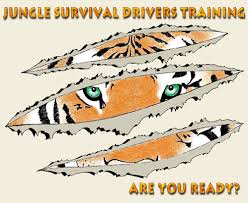
New drivers must face many challenges: navigating intersections, keeping correct lane positioning, establishing a point of decision, and for some, like freshman Nick Jovanovic, tuning out the annoying rain sounds played in the background of driving lessons.
“[The instructors] would just play rainforest noises randomly,” Nick said, “and the fans were always so loud. You’d just sit there for two hours listening to the instructors talk on and on. And the room was super distracting too because it was jungle-themed.”
Like many in the Forest Hills community, Nick completed his driver’s training courses through Jungle Survival Driver’s Training. And also like many—after three long weeks of classes—he found that the courses were not particularly exciting. Aside from a five-minute break halfway through the lesson, students spend the entirety of the two hours sitting silently, jotting down notes from the instructor. For some, the sedentary environment fails to promote any engaging activity, and the monotonous note-taking—while maybe helpful on the state test—does not prove to help on the first day of class when students are faced with driving on busy, hectic roads for the first time.
“I feel like [the instructors] could have prepared us better for the highway,” Nick said. “We didn’t get to see how the car worked before or anything. But some of the instructors were good. Some just told random stories that I think were 100% fake and were meant to make us nervous, and some would just talk the whole time. They’d also show us random videos of cars getting steamrolled by trucks to try to scare us for no reason.”
The long duration of class times, however, prevents students from having an immense workload outside of class. The two memorization-based quizzes are relatively simple to remember with the provided acronyms, and instructors waste no time ensuring that students catch on as quickly as possible. The final exam—in which students receive three opportunities to pass until they must retake the course—focuses on bigger-picture concepts of driving rather than trivial, minute details, making it trouble-free to pass for those who understand the main ideas of the road.
“I still use some of the basic stuff they taught,” Nick said. “The intersection lessons were helpful, but I didn’t study for one quiz, and I don’t remember a lot of the smaller things they taught. I don’t really feel like it makes a difference either way. Plus, the workload was so easy that I didn’t really have to study for a single thing.”
As the class progresses and students get more comfortable in the driver’s seat, getting behind the wheel becomes a lot less daunting to some. While some of the efforts by instructors to keep stress down to a minimum go unnoticed, the courses—whether one takes note of it or not—build a foundation for safe driving in the future. In high-stakes and stressful situations, having a helpful reminder to check your mirrors or slow down a bit can alleviate a lot of unnecessary nerves that one without much knowledge may experience, especially in slippery winter conditions. For freshman and new driver Ulrich Dongmo, the courses do a great job of keeping driving a calm experience regardless of the road conditions.
“I’ve driven in the snow before, and it’s not that stressful,” Ulrich said. “[The instructors] prepare you really well for weather like snow and rain, so I never really feel stressed out while I’m driving. And, they taught us a lot about merging onto highways, so it’s really easy now,”
With new tactics to drive safely learned each week, driving only gets easier and easier for most students. While it is easy to get tired of the long classes and lengthy after-school requirements, some prefer to look on the positive side—or, rather, the realistic side. Anyone who wants to drive in the future must legally take driver’s training courses, and while it is easy to find the negatives in the experience, the ability to drive ultimately outweighs them.
“Yeah, the classes are boring, but if you want to drive, you just have to deal with it,” said Ulrich, who also recently completed his driver’s training classes. “And, [once you can drive by yourself ], then you can do a lot of things that you can’t do right now. You won’t have to listen to the radio anymore, and you’ll be able to drive and get your own stuff done. So, the classes are worth it.”
While some driver’s training schools adopt ideals closer to Jungle’s mantra of being “thrown into the jungle,” other classes encourage students—prior to driving on main roads—to have some experience. Some instructors, like FHC resource room teacher Todd Hartman, who teaches driver’s training at Main Street Driving, appreciate when those taking the class have had some time behind the wheel before jumping straight into the hustle and bustle of busier roads.
“I’ve actually asked kids if they’ve driven before, and it definitely helps,” said Hartman, who has been teaching driver’s training in the summertime for 24 years. “Even driving a golf cart or riding a lawnmower, or anything that requires that spatial awareness, totally helps. Some kids will get in [the car], and they won’t know how to even start it.”
For most schools, the requirement to pass the class remains the same: Students must complete six hours of driving time, four hours of back-seat observation, and 24 hours of class time, all of which are in the presence of a registered instructor. Those taking the classes must also score 100% on two memorization-based quizzes and at least 70% on the “final exam” to pass the class.
To some, this education may seem extreme. However, such schooling is necessary to maintain safe driving habits, especially in the dangerous winter conditions that are prominent in Michigan. Driving recklessly not only puts the driver at risk but also places everyone else on the road in potentially threatening circumstances. With traffic fatalities increasing yearly, learning the proper maneuvers to drive—while they may seem trivial—decreases the chance of ending up in a dangerous situation on the road and makes driving a more efficient process to master.
“We always try to prepare the kids for what they are going to face on a drive,” Hartman said. “We want to teach the rules and laws of the road but also try to pull in personal experiences that they may have experienced on their drives or as a passenger. And, there is a lot of information you give [the students], but what we try to do is design the classroom to prepare the kids for what they’re going to see while driving.”



























































































